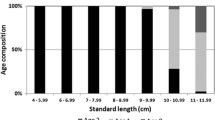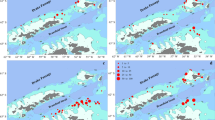Summary
The traditional method of studying age structure of krill populations through length-frequenc histograms is negated by laboratory and field observations that krill revert to an immature form and regress in size after spawning-indeed, this is part of their over-wintering strategy. Study of the age pigment lipofuscin reveals that, in the Prydz Bay population, five age classes of adult krill were present. It is suggested that these classes correspond to year cohorts. The size as measured by the length from the rostrum to the rear of the cephalothorax, remained relatively constant. However, when length data for a complete year of samples from the South Atlantic was re-analysed, evidence was found in support of the size regression hypothesis.
Similar content being viewed by others
References
Bargmann HE (1945) The development and life-history of adolescent and adult krill Euphausia superba. Discovery Rep 23:103–76
Denys CJ, McWhinnie MA (1982) Fecundity and ovarian cycles of the Antarctic krill Euphausia superba (Crustacea Euphausiacea). Can J Zool 60:2414–23
Ettershank G (1983) A new approach to the problem of longevity in the Antarctic krill Euphausia superba Dana. J Crustacean Biol (in press)
Ettershank G, Macdonnell I, Croft R (1982) The estimation of age in the fleshfly Sarcophaga bullata using the age pigment lipofuscin. Aust J Zool 31:131–138
Ikeda T, Dixon P (1982) Body shrinkage: a possible over-wintering stragey of the Antarctic krill (Euphausia superba Dana). J Exp Mar Biol Ecol 62:143–151
Ivanov BG (1970) On the biology of the Antarctic krill Euphausia superba. Mar Biol 7:340–351
Mackintosh NA (1972) Life cycle of Antarctic krill in relation to ice and water conditions. Discovery Rep 36:1–94
McWhinnie MA, Denys CJ (1978) Antarctic marine living resources with special reference to krill Euphausia superba: assessment of adequacy of present knowledge. Rep No. NSF/RA-780489, National Science Foundation, Washington DC
McWhinnie MA, Denys CJ (1980) The high importance of the lowly krill. Nat Hist 89:66–73
Makarov RR (1975) A study of repeated maturation of females (Eucarida, Euphausiacea). Zool Zh 54:670–681
Marr JSW (1962) The natural history and geography of the Antarctic krill (Euphausia superba Dana). Discovery Rep 32:33–464
Stepnik R (1982) All-year population studies of Euphausiacea (Crustacea) in the Admiralty Bay (King George Island, South Shetland Islands Antarctic). Pol Polar Res 31:53–72
Williams R, Kirkwood JM, O'Sullivan D (1983) FIBEX cruise zooplankton data. ANARE Research Notes 7:1–163
Author information
Authors and Affiliations
Rights and permissions
About this article
Cite this article
Ettershank, G. Age structure and cyclical annual size change in the Antarctic krill, Euphausia superba dana. Polar Biol 2, 189–193 (1983). https://doi.org/10.1007/BF00448969
Received:
Accepted:
Issue Date:
DOI: https://doi.org/10.1007/BF00448969




